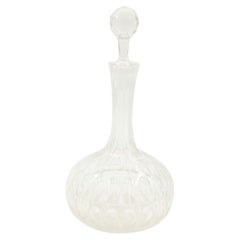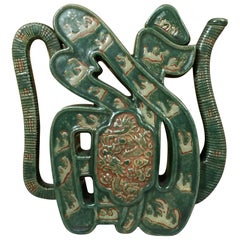19th Century Barware
Period: 19th Century
Color: White
English Cut Crystal Stoppered Decanter
Located in New York, NY
English Victorian style cut crystal decanter with a long neck and bulbous base with an adjoining faceted stopper.
Category
Victorian Antique 19th Century Barware
Materials
Crystal
Style Kangxi Porcelain Alcohol Vase Green Family, circa 1900
Located in Beuzevillette, FR
Kangxi-style FOU (happiness) wine vase, engraved with three colors on a biscuit with a dragon in the central medallion. These vases were displayed, on the day of the celebration of t...
Category
Chinese Qing Antique 19th Century Barware
Materials
Celadon
Related Items
Rare Antique Kangxi 1662–1722 Chinese Porcelain Plate Galloping Horses
Located in Amsterdam, Noord Holland
Lovely and rare thinly potted antique Chinese porcelain plate, fully decorated. 5 galloping horses, 1 in the centre, 4 in the border. The border also has 4 endless waves.
Handcraf...
Category
Chinese Qing Antique 19th Century Barware
Materials
Porcelain
Cut Crystal Decanter by Baccarat 'Nancy'
By Baccarat
Located in LA CIOTAT, FR
A very chic round whisky decanter with stopper in clear cut crystal by Baccarat, in the 'Nancy' pattern, which was first produced in 1909. Diamond-cut on its lower half with a textur...
Category
French Art Deco 19th Century Barware
Materials
Crystal
Chinese Export Porcelain Imari Bowl finely hand painted, Qing Kangxi Circa 1710
Located in Lincoln, Lincolnshire
This is a beautiful Chinese Export porcelain footed Bowl with fine Imari hand painted decoration, which we date to the turn of the 17th to 18th century, circa 1710, Qing period, Kang...
Category
Chinese Qing Antique 19th Century Barware
Materials
Porcelain
Baccarat 'Rohan' Engraved Crystal Decanter with Stopper
By Baccarat
Located in LA CIOTAT, FR
A stunning crystal wine decanter with stopper from the renowned house of Baccarat, part of the exquisite 'Rohan' collection. Decorated in a wide band across its wide bowl with a recu...
Category
French 19th Century Barware
Materials
Crystal
Chinese Kangxi Octagonal Famille Verte Floral Painted Porcelain Vase
Located in Bishop's Stortford, Hertfordshire
A scarce Chinese Kangxi porcelain octagonal yen yen vase decorated with vases containing floral arrangements in the Famille Verte palette and ...
Category
Chinese Qing Antique 19th Century Barware
Materials
Porcelain
Free Shipping
H 7.29 in W 3.04 in D 2.21 in
Vintage Gorham King Edward Cut Crystal Wine Decanter & Stopper Barware Spirits
Located in Dayton, OH
Vintage balloon shaped Gorham Kind Edward style cut crystal wine decanter with stopper.
Category
Edwardian 19th Century Barware
Materials
Crystal
Antique Blue White Chinese Porcelain Qing Dynasty Kangxi Period Dragon Vase 1680
Located in Portland, OR
A large and rare antique Chinese Qing Dynasty Blue & White Porcelain Rouleau dragon vase, Kangxi period (1662-1722), the vase dating to the late 1600s.
The vase of slightly tapered ...
Category
Chinese Qing Antique 19th Century Barware
Materials
Porcelain
Vintage Baccarat Cut Crystal Decanter
By Baccarat
Located in LA CIOTAT, FR
A very stylish cut crystal lidded decanter made by renowned crystal manufacturer Baccarat. This vintage piece of classic barware features a silver-plated collar and oversized stopper...
Category
French Art Deco 19th Century Barware
Materials
Crystal, Silver Plate
Vintage Mid-Century Orrefors Crystal Decanter with Stopper
By Orrefors
Located in Soquel, CA
Elegant Mid-Century Modern vintage crystal decanter with stopper by Orrefors (Swedish, founded 1898), c. 1960's. Engraved signature to base Orrefors HM 2498 - this particular style was by Edvard Hall.
Includes original red Orrefors Sweden sticker with logo.
"Orrefors HM 2498" etched into base.
Measures 11.5" H x 3" W x 3" D.
Orrefors Glassworks was founded in 1898 on the same site where ironworks operations had been run since 1726. In the same year that the glassworks was founded, a hot shop was built for making technical, medical and household glass and stemware to make use of waste wood and labour. Glass now replaced the less profitable ironworks operations.
In 1913, Consul Johan Ekman from Gothenburg became the new owner of Orrefors Glassworks. He appointed Albert Ahlin as manager of the glassworks and this marked the start of a new era. In 1914, Orrefors started manufacturing crystal products, and as well as cut crystal according to purchased patterns and samples, Orrefors made art glass using the overlay technique with etched decoration. The new management quickly saw that artists were needed in the business, so Simon Gate was employed in 1916 and was joined by Edward Hald a year later.
That same year, Gate and Hald made their first tentative attempts at figure engraving. They also experimented with the new innovative graal (grail) glass technique that was developed at Orrefors by the master glassblower Knut Bergqvist. The major successes were achieved a few years later at the Gothenburg Exhibition in 1923, and in particular at the Paris Exhibition in 1925. The thin engraved glass was admired by the surrounding world, and both Orrefors and the artists themselves were awarded the Grand Prix.
The successes of Simon Gate and Edward Hald in Paris in 1925 constituted the start of the long Orrefors tradition of creative design closely combined with genuine and innovative craftsmanship.
Since then, new designers and skilled glassmakers have continued in the spirit of Gate and Hald. Vicke Lindstrand and Edvin Öhrström with the new glass technique called Ariel in the 1930s. Sven Palmqvist with Kraka and Ravenna in the 1940s. And in the 1950s with Fuga, which, along with Nils Landberg’s slender tulip-shaped glass “Tulpan” and Ingeborg Lundin’s apple-shaped vase “Äpplet”, are now seen as symbols of the renaissance of Swedish design. The 1960s are associated with Gunnar Cyrén’s Pop glass, and in the 1970s, Eva Englund, Olle Alberius, Lars Hellsten and Jan Johansson as well as Cyrén worked at the glassworks.
Since the 1980s, designers such as Anne Nilsson, Erika Lagerbielke, Helen Krantz, Matz Borgström, Per B Sundberg, Martti Rytkönen, Lena Bergström, Ingegerd Råman, Malin Lindahl and Efva Attling...
Category
Swedish Mid-Century Modern 19th Century Barware
Materials
Crystal
19th Century Chinese Famille Verte Porcelain Garlic Mouth Vase, Kangxi Marks
Located in Ottawa, Ontario
The globular body decorated with hand applied enamels depicting nobles taking tea while surrounded by attendants and small children. The slender neck rising to a bulbous mouth (seemingly ground), the underside of the base showing small firing cracks and blue under-glaze double ring Kangxi marks...
Category
Chinese Qing Antique 19th Century Barware
Materials
Porcelain
Chinese Export Porcelain Imari Bowl with Wood Stand, Qing Kangxi, Circa 1700
Located in Lincoln, Lincolnshire
This is a beautiful Chinese Export porcelain footed Bowl with fine Imari hand painted decoration, dating to the Qing, Kangxi period, circa 1700. The bowl comes with a Chinese hardwoo...
Category
Chinese Qing Antique 19th Century Barware
Materials
Porcelain
Kangxi Marked Chinese Large Plate Porcelain Blue & White Flower Bask, circa 1700
Located in Lincoln, Lincolnshire
This is a beautifully hand-painted Chinese porcelain blue and white large plate from the Qing, Kangxi period, 1662-1722.
The plate is finely potted with a carefully cut base rim a...
Category
Chinese Qing Antique 19th Century Barware
Materials
Porcelain
Read More
Handmade with Lab-Grade Glass, This Decanter Holds Your Favorite Cocktail Concoctions
Artist Simone Crestani conjures the fascination you remember from Chemistry 101.
28 Cheerful Home Bars, Where Everybody (Literally) Knows Your Name
Simple or sophisticated, equipped with console, cart or custom cabinetry, these stylish bar areas deserve a toast.
20 Toast-Worthy Bars
Raise a glass to good design. In these sophisticated drinking destinations, there's always something to celebrate.
Recently Viewed
View AllMore Ways To Browse
Retro Champagne Bottle
Vintage Liquor Art
Mid Century Wine Rack
Baccarat Crystal Bar
Tantalus Bar
Shot Glasses Barware
Wine Barrel Furniture
Decanter Glass Czech Republic
Iconic Barware
Art Deco Silver Ice Bucket
Liqueur Bar
Wine Pour
Wine Pourer
Mid Century Shot Glass
Pouring Wine
Carved Stopper
Modern Liquor Glasses
Midcentury Shot Glasses



